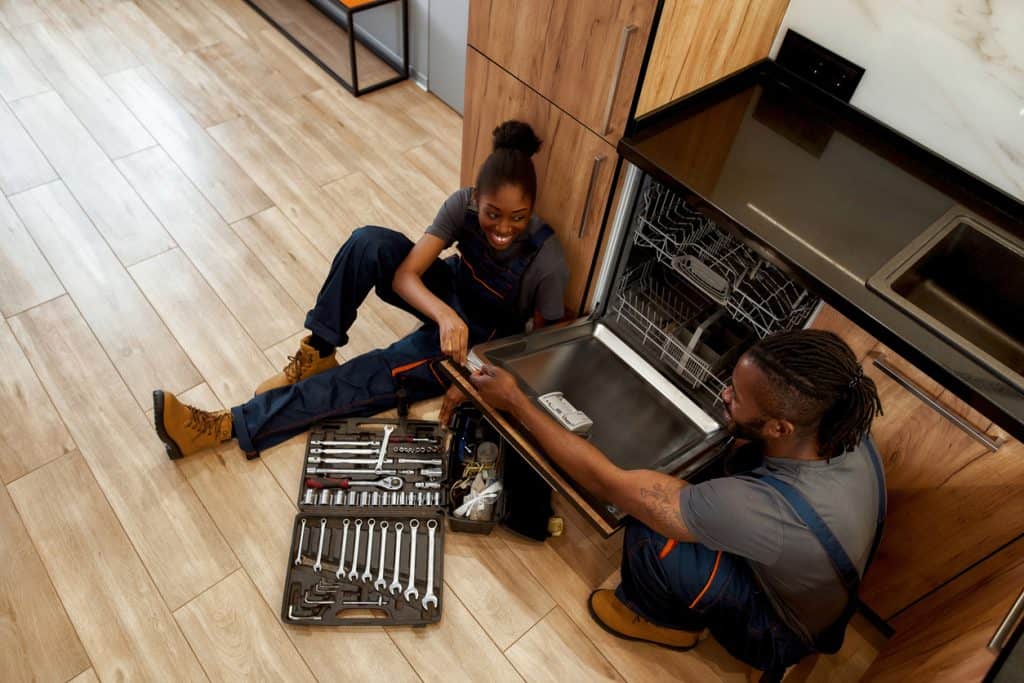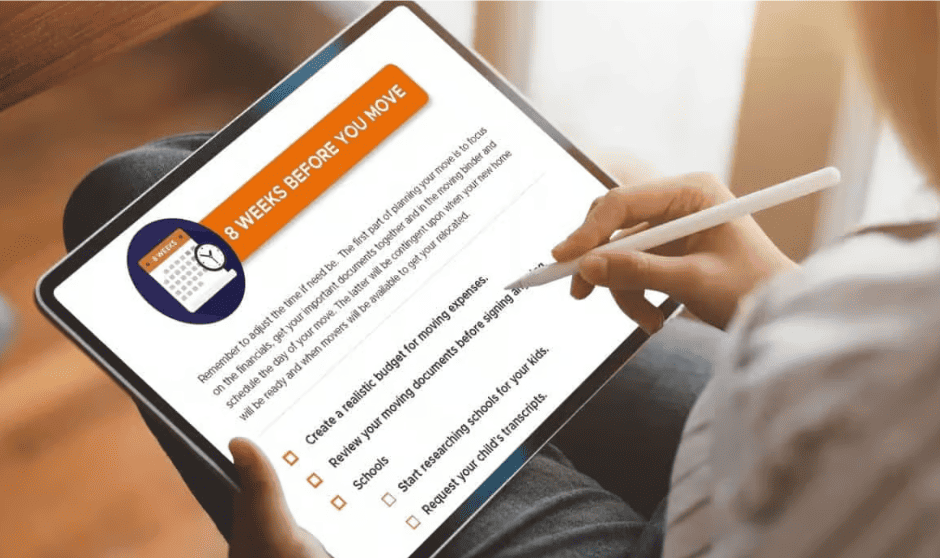Moving day is right around the corner, and while you may have scheduled your movers and started the packing process, there’s still a lot to be done to ensure a smooth and stress-free moving day. Expert Houston movers, Blue Ox Moving & Storage has compiled this comprehensive guide to walk you through the essential steps to prepare for moving day to make it as stress-free as possible.
Want to know just how to prepare for moving day? The key to a successful move is thorough preparation. Here are all the essential things you need to do to get ready for moving day:
Prepare All Appliances

Preparing all your appliances before your movers arrive is essential to ensure a smooth and efficient moving process. Here are some detailed steps to help you get everything ready:
Create a Checklist
Start by deciding which appliances you intend to take with you. Create a complete list of all of the items. This typically includes washing machines, refrigerators, dishwashers, stoves, and any other large appliances. A clear list will help you stay organized.
Read the Manuals
Before disconnecting any appliance, consult the user manuals or manufacturer’s instructions. These documents often provide specific guidance on safely disconnecting and preparing the appliance for transport. Follow these instructions carefully to avoid damage or safety hazards.
Unplug and Turn Off
Start by unplugging each appliance from the electrical outlet. If applicable, turn off the power supply at the circuit breaker or fuse box to ensure complete safety. This step is crucial to prevent electrical accidents during the moving process.
Disconnect Water and Gas Lines
You’ll need to disconnect the water and gas lines for appliances like washing machines and gas stoves. Refer to the manual to determine the tools you’ll need and the steps you should take to do this. Use appropriate tools to disconnect these connections safely, and be sure to cap or plug any exposed pipes to prevent leaks or damage.
Empty and Clean
Empty the interiors of refrigerators, freezers, and other appliances that store food. Thoroughly clean and dry these appliances to prevent mold or odors from developing during transit. Remember to refer to the product manual for the best cleaning methods.
Secure Loose Parts
You’ll want to have loose parts together when it’s time to hook up your appliances in your new place. Remove loose or detachable parts from your appliances, such as shelves, drawers, or removable doors. Wrap and pack these parts separately to avoid damage or loss.
Label Cords and Parts
You may not remember just what cords belong where once you arrive in your new home. So, label all cords, hoses, and parts with their corresponding appliance or a numbered system. This will make it easier to reassemble everything correctly when you arrive at your new home.
Prepare Your Furniture to Prepare for Moving Day

Preparing your furniture for a move is an essential step to ensure the safety of your items and a smooth moving day experience. If your professional movers don’t handle the disassembly of your furniture, taking the initiative to do it yourself can make a significant difference. Here’s a guide on how to prepare your furniture effectively:
- Protect Fragile Parts. For delicate or easily scratched components, like glass tabletops or intricate woodwork, use protective materials such as bubble wrap, blankets, or furniture pads to prevent damage during the move.
- Label and Bag Hardware. As you disassemble each piece of furniture, place all the hardware (screws, bolts, nuts, etc.) in separate resealable plastic bags. Label each bag clearly with the name of the furniture piece it belongs to. You can also tape the bags to the corresponding furniture part to ensure they aren’t misplaced.
- Take Photos. Before disassembling complex furniture items, take photos of each step to reference during reassembly. This can be particularly helpful for items like bookshelves with many shelves or beds with multiple slats.
- Dismantle Beds. Disassemble beds by removing the headboard, footboard, and side rails. If you have a platform or slat bed, disassemble it carefully and pack the slats securely. Keep all associated hardware with the bed components.
- Take Apart Tables. For dining tables, remove the legs if possible. If your table has a glass top, ensure it is adequately protected with padding or cardboard. Secure any table leaves separately.
- Wrap Mattresses and Box Springs. Protect mattresses and box springs with special mattress bags or covers to keep them clean and free from dirt during the move.
- Keep Assembly Tools Accessible. Keep your tools, hardware bags, and assembly instructions handy during the move. You may need them to reassemble furniture at your new residence.
Handle Utility Services

Ensure you’ve scheduled and confirmed the disconnection or transfer of your utilities. It’s advisable to schedule utility disconnections for the day after your move. Remember to return any equipment provided by the service providers.
Schedule Disconnections or Transfers
Don’t forget your utilities. Arrange for disconnecting or transferring your utilities on or around your moving day. Coordinate the timing to minimize any disruptions to your daily life. You may want to overlap service days so you won’t end up with power or water in your old home before the move.
Check for Outstanding Bills
You don’t want to discover a hefty bill once you’ve settled into your new home. Verify that all outstanding bills have been settled with your current utility providers. It’s essential to ensure that no overdue payments or pending charges could affect your disconnection or transfer requests.
Arrange for Final Meter Readings
For utilities like electricity, gas, and water, arrange for final meter readings to determine your consumption up to the moving date accurately. This helps ensure that you are billed correctly and not responsible for any usage after you’ve vacated the property.
Return Equipment
That leased equipment can be expensive. If you’ve rented or leased any equipment from your utility providers, such as cable boxes or modems, plan to return these items as per the providers’ instructions. Return rented equipment to avoid additional charges.
Verify Transfer of Deposits
Don’t leave any money on the table. If you’ve placed deposits with utility providers, confirm that they will be transferred to your new address or refunded. Keep records of these transactions for your reference.
Handle Personal Details
Handling your personal details and updating your address is critical to ensuring a smooth transition during a move. Here’s how:
Banking and Financial Accounts
Visit your bank or access your online banking portal to update your address on your checking account. This ensures that your financial institution has your current contact information for statements and correspondence.
Review your bank statements and identify any auto drafts or recurring payments for services you won’t be using at your new address. Contact the service providers to cancel or update your billing information.
Inform your credit card companies and other financial institutions about your change of address. Update your address for all credit card accounts to ensure you receive statements and important notifications.
Insurance Providers
Contact your home insurance provider to update your address for your homeowner’s or renter’s insurance policy. Ensure your coverage remains in effect at your new location and adjust it as needed.
Notify your auto insurance provider about your move. Verify that your coverage remains valid in your new area and update your policy as necessary to meet local requirements.
Update your health insurance provider with your new address to ensure seamless access to healthcare services. Check for any changes in your coverage or network of healthcare providers.
Insurance Rate Comparison
Take the opportunity to compare insurance rates based on your new location. Insurance premiums can vary depending on where you live, so getting quotes tailored to your new address and needs is essential.
Government Agencies
Visit the official website of the United States Postal Service (USPS) or your local post office to change your mailing address.
If you receive Social Security benefits, update your address with the Social Security Administration to continue receiving your payments without interruption.
Notify the IRS of your address change to ensure that you receive important tax documents and refunds at your new location. You can typically update your address online through the IRS website.
Online Accounts
Log in to your favorite online shopping sites and update your shipping address in your account settings. This prevents packages from being sent to your old address.
Contact your creditors, utility companies, and other billers to update your billing address. This includes credit card companies, internet service providers, and subscription services.
Professional Contacts
Notify your employer of your change of address, especially if your payroll or benefits information is mailed to you.
Update your address with your healthcare providers, including your primary care physician and specialists.
Don’t forget to update your driver’s license and vehicle registration with your new address through your local Department of Motor Vehicles (DMV).
Prepare Your Kids

If you are moving with kids, make sure to inform their current childcare provider and school about the move. Enroll them in their new school and have a discussion with them about the moving process to ease their fears. Involve them in packing and setting up their new room. Explore the new community with them by visiting local parks and attractions.
Get The Pets Ready

For your furry friends, arrange transportation, boarding, or sitting for moving day. Ensure that their identification tags and microchip registrations have updated contact information. Create a comfortable space in your home away from the moving chaos for your pets. Keep a photo of your pet on your phone in case they become separated from you. If they’ll be present on moving day, have food and water readily available and try to stick to their routine as much as possible.
Put Together Your Moving Day Bag
Keep a bag with essential items you’ll need on moving day, including your packing inventory, paper towels, toilet paper, personal care items, prescription medications, a tool kit, device chargers, refreshments, a first-aid kit, trash bags, snacks, and toys or blankets for your kids or pets. Remember to include pajamas and linens for the beds.
Final Packing
Final packing is crucial to ensure a smooth and organized moving process. It involves completing the packing of your belongings, addressing any last-minute items, and ensuring that everything is correctly labeled for an efficient move. Here’s how to handle final packing effectively:
Check Every Room
Go through each room in your home one final time to ensure that all items are accounted for and that nothing has been overlooked—open drawers, closets, and cabinets. Take care of any last-minute items you left out, such as personal toiletries, essential kitchen utensils, or items you need for immediate use upon arrival at your new home.
Label Boxes Clearly to Prepare for Moving Day
Properly label every box with its contents and the room it belongs to. Use a permanent marker to write legible descriptions on each box’s sides. This simplifies the unpacking process and makes it easier for your movers to place the boxes in the correct rooms at your new home.
Seal Boxes Properly
Seal all boxes securely with strong packing tape. Make sure the bottoms are well-taped to prevent items from falling out during the move.
Inventory List
Maintain an inventory list of all the boxes and their contents. This list can be cross-referenced with your labels, helping you keep track of everything and ensuring nothing is lost.
Final Walkthrough
After everything is packed and labeled, conduct a final walkthrough of your home to verify that nothing has been left behind and that all doors and windows are locked.
On Moving Day
When moving day finally arrives, you want to be organized and ready to go. Start early and begin your day with a good breakfast. Do a final walkthrough, ensuring you have everything you need. Check that all windows and doors are locked and appliances are turned off. Follow all the moving tips, stay hydrated, and take breaks as needed. Stay positive, be flexible, and keep calm if things don’t go as planned.
Download the Ultimate Moving Checklist

As early in the moving process as possible, download the Ultimate Moving Checklist. This handy guide is divided into weekly tasks to help make your move less stressful. Moving is one of the top ten stressors in life, but with proper planning, it doesn’t have to be anxiety-filled.
Follow Along
Our Ultimate Local Move Moving Checklist breaks down each stage of your move into weekly tasks. It covers planning your finances, deciding what to keep and pack, gathering materials, confirming your home movers, and preparing for moving day.
Print it Out
While you can keep the checklist on your iPad, having a printed version with all your moving documentation can be handy. Check off completed tasks as you go.
Organize Your Complete Move
To prepare like a pro, start with a binder to organize everything. Use the checklist to plan your move effectively.
Don’t Forget A Thing
Our checklist covers organizing important documents, preparing your schedule for moving day, and offers other essential moving tips. We’ve tried to think of everything you might need.
Confirm With Your Trusted Moving Company
Preparing for the moving day may seem daunting, but with the proper planning and assistance from Houston movers Blue Ox Moving & Storage, you can ensure a smooth and stress-free relocation to your new home. The Blue Ox Ultimate Moving Checklist will guide you through each step of the process, making your move more manageable and organized. Remember, moving doesn’t have to be overwhelming when you have a trusted partner by your side.
Contact Blue Ox Moving & Storage today and let us help make your move a success!
